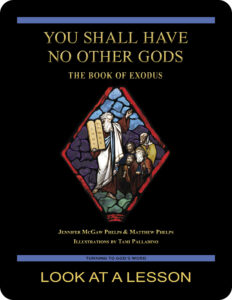 You Shall Have No Other Gods:
You Shall Have No Other Gods:
The Book of Exodus
Lesson 1 The More the People Are Oppressed, the More They Multiply
the book of Exodus 1:1–22
Revised Standard Version Catholic Edition (RSVCE)*
New American Bible Revised Edition (NABRE)*
Catechism of the Catholic Church
ex libris (in our library)
Aperuit Illis (Instituting the Sunday of the Word of God)
glossary for the book of Exodus
cross references in the book of Exodus
Tami Palladino’s visual-meditation journal
next lesson: God Hears His People Groaning
This material coordinates with Lesson 1 on pages 4–9 in the study book You Shall Have No Other Gods: The Book of Exodus.
And God spoke all these words, saying, ‘I am the LORD your God, who brought you out of the land of Egypt, out of the house of bondage. You shall have no other gods before me. You shall not make for yourself a graven image, or any likeness of anything that is in heaven above, or that is in the earth beneath, or that is in the water under the earth; you shall not bow down to them or serve them; for I the LORD your God am a jealous God, visiting the iniquity of the fathers upon the children to the third and the fourth generation of those who hate me, but showing mercy to thousands of those who love me and keep my commandments.”—the book of Exodus 20:1–6
welcome to our in-depth study of the book of Exodus
We invite interested groups and individuals to check out the sample first lesson from this 28- lesson Turning to
lesson Turning to  God’s Word Catholic Bible study. These online study pages link to our free lesson video overviews, as well as to a glossary and cross references in the biblical text. Other study aids include maps, additional commentary, and prayers based on the primary Scripture in each lesson. You Shall Have No Other Gods: The Book of Exodus has been granted an imprimatur and can be purchased from our website shop. If you have a Bible-study question or comment, click on one of the “ask us your question” or “what do you think” buttons on any online study page.
God’s Word Catholic Bible study. These online study pages link to our free lesson video overviews, as well as to a glossary and cross references in the biblical text. Other study aids include maps, additional commentary, and prayers based on the primary Scripture in each lesson. You Shall Have No Other Gods: The Book of Exodus has been granted an imprimatur and can be purchased from our website shop. If you have a Bible-study question or comment, click on one of the “ask us your question” or “what do you think” buttons on any online study page.
every Turning to God’s Word Bible study carries an imprimatur
 You Shall Have No Other Gods: The Book of Exodus was granted an imprimatur by
You Shall Have No Other Gods: The Book of Exodus was granted an imprimatur by  the Most Reverend William Joensen, Ph.D. (left), bishop of the Diocese of Des Moines, on June 29, 2023; the Very Reverend Aquinas Nichols, censor librorum for the diocese, granted the nihil obstat. These are official declarations that a book or pamphlet is free of doctrinal or moral error.
the Most Reverend William Joensen, Ph.D. (left), bishop of the Diocese of Des Moines, on June 29, 2023; the Very Reverend Aquinas Nichols, censor librorum for the diocese, granted the nihil obstat. These are official declarations that a book or pamphlet is free of doctrinal or moral error. 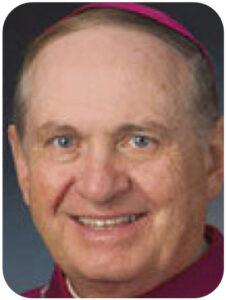 There’s no implication that those who’ve granted the imprimatur and nihil obstat agree with the contents, opinions, or statements expressed in the work. All Turning to God’s Word Catholic Bible studies are submitted to the Church before publication. Visit the archives of Lost in Translation to read more about the Latin terms imprimatur & nihil obstat. Turning to God’s Word Catholic Bible studies written before 2020 were granted imprimaturs by the Most Reverend Richard E. Pates (right), bishop emeritus of the Diocese of Des Moines.
There’s no implication that those who’ve granted the imprimatur and nihil obstat agree with the contents, opinions, or statements expressed in the work. All Turning to God’s Word Catholic Bible studies are submitted to the Church before publication. Visit the archives of Lost in Translation to read more about the Latin terms imprimatur & nihil obstat. Turning to God’s Word Catholic Bible studies written before 2020 were granted imprimaturs by the Most Reverend Richard E. Pates (right), bishop emeritus of the Diocese of Des Moines.
the popes inspire us—serious Catholics study the Word of God
In his apostolic letter Aperuit Illis (Instituting the Sunday of the Word of God) issued motu proprio (of his 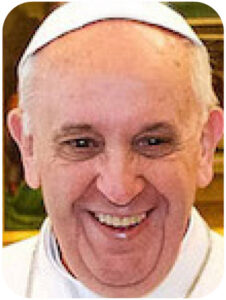 own accord), Pope Francis established the Third Sunday in Ordinary Time to be devoted to the celebration, study, and dissemination of the Word of God. The Holy Father’s apostolic letter was published on September 30, 2019, the feast of St. Jerome and the 1600th anniversary of the saint’s death. St. Jerome, who translated the Latin
own accord), Pope Francis established the Third Sunday in Ordinary Time to be devoted to the celebration, study, and dissemination of the Word of God. The Holy Father’s apostolic letter was published on September 30, 2019, the feast of St. Jerome and the 1600th anniversary of the saint’s death. St. Jerome, who translated the Latin 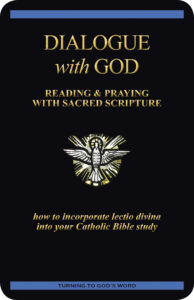 Vulgate Bible from Greek and Hebrew manuscripts, is famous for saying: “Ignorance of Scripture is ignorance of Christ,” and he’s the patron of translators and librarians. In Aperuit Illis, the Holy Father calls attention to the sacramental nature of the Word of God, pointing to the unbreakable bond between Sacred Scripture and the Eucharist. In 2025, the Church will celebrate the Word of God on Sunday, January 26. We’ve posted a free digital version of Dialogue with God: Reading & Praying with Sacred Scripture, our guide to incorporating the Church’s traditional practice of lectio divina (sacred reading) into regular Bible study.
Vulgate Bible from Greek and Hebrew manuscripts, is famous for saying: “Ignorance of Scripture is ignorance of Christ,” and he’s the patron of translators and librarians. In Aperuit Illis, the Holy Father calls attention to the sacramental nature of the Word of God, pointing to the unbreakable bond between Sacred Scripture and the Eucharist. In 2025, the Church will celebrate the Word of God on Sunday, January 26. We’ve posted a free digital version of Dialogue with God: Reading & Praying with Sacred Scripture, our guide to incorporating the Church’s traditional practice of lectio divina (sacred reading) into regular Bible study.
read more Church documents
Find links to magisterial documents referred to in Turning to God’s Word Catholic Bible  studies, including Aperuit Illis (Instituting the Sunday of the Word of God), at ex libris—magisterial documents. The page lists significant recent encyclicals as well as a number of historical Church documents.
studies, including Aperuit Illis (Instituting the Sunday of the Word of God), at ex libris—magisterial documents. The page lists significant recent encyclicals as well as a number of historical Church documents.
a few reminders about Turning to God’s Word Bible studies
The most distinguishing feature of our Bible studies is that they’re Catholic. Each one has been granted an imprimatur, which means that a bishop has read the work and found nothing contrary to Church teaching on morals or faith. Note that the imprimatur makes no claim that a work is equivalent to Church teaching, simply that it isn’t opposed to what the Church teaches. Practically speaking, this means that you don’t have to accept Turning to God’s Word interpretations of Scripture, only that choosing to do so doesn’t amount to heresy. Choosing not to accept conclusions of a work that’s been granted an imprimatur doesn’t immediately plunge you into heretical territory, but choosing not to accept Church teaching related to those conclusions does.
read the Catechism—how to avoid heresy
The imprimatur reinforces and validates the claim that Turning to God’s Word Bible studies are Catholic. All participants have a right to expect that discussions about our Bible studies will focus on Catholic teaching. That doesn’t mean that someone won’t occasionally have a question about Church teaching. Not knowing what the Church teaches about a particular issue isn’t heretical. Asking a question about Church teaching isn’t heretical. Failing to understand Church teaching isn’t heretical. Insisting that Church teaching is wrong is.
 Most people who begin to study the book of Exodus are caught off guard by how many challenging theological ideas are found in Scripture. There are a surprising number of things many Catholics believe to be Church teaching that actually are not. In this study, we attempt to present Scripture and Church teaching related to the book of Exodus as unambiguously as possible. When in doubt, you can refer to the Catechism of the Catholic Church or talk with your parish priest about any doctrine that remains unclear.
Most people who begin to study the book of Exodus are caught off guard by how many challenging theological ideas are found in Scripture. There are a surprising number of things many Catholics believe to be Church teaching that actually are not. In this study, we attempt to present Scripture and Church teaching related to the book of Exodus as unambiguously as possible. When in doubt, you can refer to the Catechism of the Catholic Church or talk with your parish priest about any doctrine that remains unclear.
If a Church teaching seems particularly unsettling even after studying the Catechism and speaking with someone who’s knowledgeable regarding Catholic doctrine, you might want to examine whether there might be a personal or emotional reason why you’re having difficulty. Pray for God’s guidance and be open to receiving a different answer than you anticipated, possibly at a later time than you expected or hoped.
be respectful of the others in your group
Keep in mind that most people in your discussion group are there for a Catholic interpretation of Scripture. People from other faith backgrounds are welcome, but the focus of any Turning to God’s Word study always is going to be Catholic in nature. The following opening prayer emphasizes maintaining mutual respect amid differences of opinion:
Heavenly Father, send forth your Spirit to enlighten our minds
and dispose our hearts to accept your truth.
Help us to listen to one another with openness and honesty,
eager to learn from the talents and intuitions that you have given each of us.
Never let differences of opinion diminish our mutual esteem and love.
May we leave this meeting with more knowledge and love for you and your Son.
In the unity of the Holy Spirit, Amen.
You can find other opening prayers on our website. We especially like the following:
Lord Jesus, you promised to send your Holy Spirit to teach us all things.
As we read and study your word today,
allow it to touch our hearts and change our lives. Amen.
WHAT DO YOU THINK about interpreting Scripture?
 The Church encourages Catholics to read and interpret Scripture on our own as long as we follow these two rules:
The Church encourages Catholics to read and interpret Scripture on our own as long as we follow these two rules:
1) Our interpretation can’t contradict anything else in Scripture.
2) Our interpretation can’t contradict Church teaching.
In order to comply, we need to know everything else that’s in the Bible as well as everything that the Church teaches. That’s a tall order, which is why each Turning to God’s Word Catholic Bible study is submitted to the Church for an imprimatur. The imprimatur for You Shall Have No Other Gods: The Book of Exodus is a guarantee that the Church finds nothing objectionable in the work. You’re free to agree with interpretations in You Shall Have No Other Gods: The Book of Exodus, but it’s not essential that you do so. There are many different interpretations in other commentaries, but very few of them carry an imprimatur. This doesn’t mean that they necessarily pose any problems in regard to Catholic doctrine or moral teaching, but there’s no Church guarantee that they don’t.
When considering opinions that haven’t been granted an imprimatur, don’t be afraid to ask questions. Our Bible studies address some common interpretations, but there are innumerable opinions floating around about the meaning of different passages in the Bible—including in the book of Exodus.
 ? Here’s the first question to ask about an opinion expressed in any commentary: How closely does it adhere to what we can read in the biblical text?
? Here’s the first question to ask about an opinion expressed in any commentary: How closely does it adhere to what we can read in the biblical text?
? Do viewpoints about the meaning of the Bible passages contradict anything else you already know from Scripture?
? Do they contradict anything from Church teaching? The Catechism of the Catholic Church addresses a large number of questions related to common Scripture interpretations.
map notes—setting the stage
The land of Canaan promised to the descendants of Jacob is part of an area often referred to as the Fertile Crescent. River-based trade in the ancient Near East traced a route from the Nile River in Egypt northward along the coastline of the Mediterranean Sea before veering toward the Tigris and Euphrates 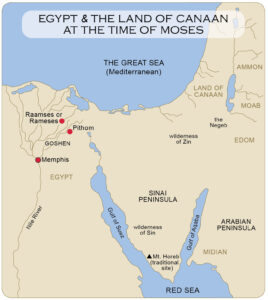 Rivers in Mesopotamia (present-day Iraq). The descendants of Jacob occupied a narrow strip of land along the Dead Sea and Jordan River. Precariously situated in the middle of the trade routes linking Egypt and Mesopotamia, the area is roughly 150 miles long and 60 miles wide and is marked by diverse geography. In the central region, the terrain climbs to about 3,000 feet above sea level; 25 miles away, the Dead Sea registers 1,290 feet below sea level, the lowest place on the planet. The northern region around Galilee is hilly and fertile, while the Negeb (sometimes called the Negev) to the south of the Dead Sea is an arid wilderness. Click on the map (right) to enlarge it. The original map is on page 9 in You Shall Have No Other Gods: The Book of Exodus.
Rivers in Mesopotamia (present-day Iraq). The descendants of Jacob occupied a narrow strip of land along the Dead Sea and Jordan River. Precariously situated in the middle of the trade routes linking Egypt and Mesopotamia, the area is roughly 150 miles long and 60 miles wide and is marked by diverse geography. In the central region, the terrain climbs to about 3,000 feet above sea level; 25 miles away, the Dead Sea registers 1,290 feet below sea level, the lowest place on the planet. The northern region around Galilee is hilly and fertile, while the Negeb (sometimes called the Negev) to the south of the Dead Sea is an arid wilderness. Click on the map (right) to enlarge it. The original map is on page 9 in You Shall Have No Other Gods: The Book of Exodus.
 so what’s the point of studying the book of Exodus? (52:24)
so what’s the point of studying the book of Exodus? (52:24)
Every online study page for You Shall Have No Other Gods: The Book of Exodus  includes the link to a free video in which Turning to God’s Word author Matthew Phelps addresses the main ideas in the biblical text, following the same Scripture ranges as questions in the study book. The overview for Lesson 1 opens with main themes in the book of Exodus, including how it is that this ancient Scripture is relative for Christians. Key to understanding what’s going on with the book of Exodus is tracing the development of Moses’ relationship with God. This mirrors the relationship that God wants to establish
includes the link to a free video in which Turning to God’s Word author Matthew Phelps addresses the main ideas in the biblical text, following the same Scripture ranges as questions in the study book. The overview for Lesson 1 opens with main themes in the book of Exodus, including how it is that this ancient Scripture is relative for Christians. Key to understanding what’s going on with the book of Exodus is tracing the development of Moses’ relationship with God. This mirrors the relationship that God wants to establish  with the descendants of the patriarchs Abraham, Isaac, and Jacob—and with all of humanity. The book of Exodus offers practical advice for men and women who are seeking a more intimate relationship with God.
with the descendants of the patriarchs Abraham, Isaac, and Jacob—and with all of humanity. The book of Exodus offers practical advice for men and women who are seeking a more intimate relationship with God.
The Scripture ranges for the videos that accompany this Catholic Bible study from Turning to God’s Word match the Scripture ranges for the sets of questions in You Shall Have No Other Gods: The Book of Exodus. You can follow along as Turning to God’s Word author Matthew Phelps discusses Lesson 1, “The More People Are Oppressed, the More They Multiply,” on pages 4–9 in the study book.
no one is exactly sure when the Exodus took place
The First Book of the Kings 6:1 sets the time of the Exodus 480 years prior to when Solomon authorized building the temple in Jerusalem, suggesting a date for the Exodus of around 1450 B.C. The book of Exodus 1:11, however, describes a pharaoh putting the Hebrews in Egypt to work building the cities of Pithom and Raamses. Scholars have been unable to pinpoint the location of Pithom, but some scholars argue that Raamses is Pi-Ramesses, a store-city built by Ramesses II, the Egyptian pharaoh sometimes referred to as Ramesses the Great. The spelling of his name varies considerably, and it’s uncertain whether all of the variant spellings refer to him or to a different person with a similar name. Ramesses the Great is believed to have reigned in Egypt from 1279 to about 1213 B.C. Those dates fail to match up well with the biblical time frame (about 800 years are unaccounted for), so the exact historical date of the Exodus and the pharaoh ruling Egypt at that time remain a mystery.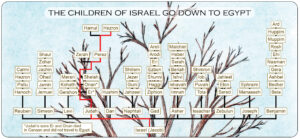 who are the sons of Israel who went into Egypt?
who are the sons of Israel who went into Egypt?
The biblical text for Lesson 1 names the heads of each of the 12 tribes, whose descendants are related to the patriarchs Abraham, Isaac, and Jacob. A complete listing of all of the  males in Jacob’s family who entered Egypt can be found in the book of Genesis 46:8–27. The chart (above) depicts the biblical listing as branches on a family tree; click on the chart to enlarge it. The lineage of Jesus, who’s born into the line of Judah (the fourth son of Jacob), is in red. The original chart is on page 7 in You Shall Have No Other Gods: The Book of Exodus and on page 149 in Lesson 27 Thus Israel Dwelt in Egypt in the study book In the Beginning: The Book of Genesis. The Turning to God’s Word study of the book of Genesis contains background pertaining to the book of Exodus, including details about the first major practitioners of the Hebrew faith—Abraham, Isaac, Jacob, and Joseph.
males in Jacob’s family who entered Egypt can be found in the book of Genesis 46:8–27. The chart (above) depicts the biblical listing as branches on a family tree; click on the chart to enlarge it. The lineage of Jesus, who’s born into the line of Judah (the fourth son of Jacob), is in red. The original chart is on page 7 in You Shall Have No Other Gods: The Book of Exodus and on page 149 in Lesson 27 Thus Israel Dwelt in Egypt in the study book In the Beginning: The Book of Genesis. The Turning to God’s Word study of the book of Genesis contains background pertaining to the book of Exodus, including details about the first major practitioners of the Hebrew faith—Abraham, Isaac, Jacob, and Joseph.
who lives in the land of Canaan?
It can be difficult to keep track of all the people inhabiting the land of Canaan at the time of Moses. The book of Exodus 3:8 and 3:17 list some of these groups as “the Canaanites, the Hittites, the Amorites, the Perizzites, the Hivites, and the Jebusites.” All are considered Canaanites, but not all are listed in the Table of Nations in the book of Genesis 10:6–20 as descendants of Noah’s grandson Canaan. The Hittites are descended from Canaan’s son Heth, the Amorites from his son Emer, and the Jebusites from his son Jebus. The Hivites and Perizzites also are classified as Canaanites, and scholars speculate that these groups may take their names from ancient Hebrew words used to identify rural people or  inhabitants of small villages. The book of Exodus includes a number of relatively unfamiliar names. To learn more about the people and places that appear in this study, visit our online glossary, which includes the meaning of many names in the book of Exodus.
inhabitants of small villages. The book of Exodus includes a number of relatively unfamiliar names. To learn more about the people and places that appear in this study, visit our online glossary, which includes the meaning of many names in the book of Exodus.
covenant—you could look it up in our archives
 At the heart of Christianity is the New Covenant, the foundation of which is the Old Covenant. The book of Exodus describes the Old Covenant in some detail. To learn more about the spiritual laws that continue to govern human life and death even into the present day, read Lost in Translation, an online column in which Turning to God’s Word author Matthew Phelps helps readers connect with ideas expressed in the original languages of the Scriptures. New Lost in Translation entries are posted on Mondays, and past entries are archived on our website. Contact us if you’d like to receive Lost in Translation by email every week.
At the heart of Christianity is the New Covenant, the foundation of which is the Old Covenant. The book of Exodus describes the Old Covenant in some detail. To learn more about the spiritual laws that continue to govern human life and death even into the present day, read Lost in Translation, an online column in which Turning to God’s Word author Matthew Phelps helps readers connect with ideas expressed in the original languages of the Scriptures. New Lost in Translation entries are posted on Mondays, and past entries are archived on our website. Contact us if you’d like to receive Lost in Translation by email every week.
read the Catechism—how does the Church view the Old Testament?
Paragraphs 122 and 123 in the Catechism of the Catholic Church explain why it is that Christians should become familiar with the Old Testament. 
122 Indeed, “the economy of the Old Testament was deliberately so oriented that it should prepare for and declare in prophecy the coming of Christ, redeemer of all men.” “Even though they contain matters imperfect and provisional,” the books of the Old Testament bear witness to the whole divine pedagogy of God’s saving love: these writings “are a storehouse of sublime teaching on God and of sound wisdom on human life, as well as a wonderful treasury of prayers; in them, too, the mystery of our salvation is present in a hidden way.”
123 Christians venerate the Old Testament as true Word of God. The Church has always vigorously opposed the idea of rejecting the Old Testament under the pretext that the New has rendered it void (Marcionism).
what is Marcionism?
This heresy, named after a ship owner called Marcion, began in Rome around the middle of the 2nd century A.D. Although Marcion accepted Jesus as Savior of the world, he rejected that the God of the New Testament was the same as the God revealed in the Old Testament, whom he saw as the author of evil and lesser than the God revealed by Jesus. Several early Christian apologists of the time criticize Marcionism, including St. Justin Martyr, St. Irenaeus of Lyon, and St. Hippolytus of Rome.
the book of Exodus is part of the Pentateuch
“Pentateuch” is a Greek word meaning “five books” or “five-part writing.” In connection with the Bible, the Pentateuch refers to the first five books in the Old Testament—the books of Genesis, Exodus, Leviticus, Numbers, and Deuteronomy, which can be considered five continuous volumes of the same work. Present-day Jews frequently refer to the Old Testament as the Hebrew Scriptures.
one focus of the book of Exodus is the Law
Torah—תורה—is a Hebrew word used to refer to the Pentateuch (those first five books in the Old Testament). It means “teaching,” “direction,” “guidance,” and “law.” Because the Torah tells the story of God’s law given to the descendants of Jacob, the first five books in the Old Testament also are referred to as the Law and are considered foundational to Hebrew and later to Jewish faith, which developed out of Hebrew worship practices. While all five books pertain to the Law, it’s the book of Exodus that’s most concerned with describing how the law came to the Israelites in the form of the Ten Commandments.
about the Documentary Hypothesis
Hebrew tradition holds that Moses wrote the Pentateuch, an idea that’s challenging since the book of Deuteronomy 34:1–8 describes Moses’ own death and burial. “Who Wrote the Book of Exodus?” on page 9 in You Shall Have No Other Gods: The Book of Exodus addresses the idea that the book of Exodus (and indeed all five books of the Torah) may have been written by four authors or four groups of authors. Multiple repetitions and other details in the book of Exodus appear to suggest that possibility. Although no ancient manuscripts or fragments exist to support the Documentary Hypothesis, most serious Scripture scholars favor some version. The four sources often are referred to individually in some biblical commentaries. While the dates can vary, generally they’re characterized as follows:
‘J’ or Yahwist—This source is believed to be the oldest, written in the 10th or 9th century B.C. God is referred to as Yahweh—from YHWH (four consonants known as the Sacred Tetragrammaton), God’s personal and unpronounceable name. The author (or authors) of these sections assumes the literary style of a story-teller. Sections of the Pentateuch attributed to the Yahwist source appear to have been written to demonstrate that God’s promises to Abraham were fulfilled in the kingdom of David. The Yahwist source favors the southern kingdom of Judah. The ‘J’ identifier for this source comes from the Latinized translation of YHWH as Jehovah.
‘E’ or Elohist—Scholars think that the Elohist sections of the Pentateuch were written around 900 B.C., and the writing favors the northern kingdom of Israel. The Elohist source stresses morality, the role of the prophet, and the importance of Jacob and of the covenant with Moses. God is referred to as Elohim, a plural form of the Hebrew honorific for God. In Scripture, Elohim generally takes singular verbs and pronouns. The ‘E’ identifier for this source comes from its use of Elohim to refer to God.
‘D’ or Deuteronomist—The Deuteronomist sections of the Pentateuch are believed to have been written in the 7th and 6th centuries B.C. This source differs from the Priestly source in that it reflects the point of view of the northern kingdom of Israel, stressing the importance of covenant over kingship. The Deuteronomist source reassesses material in the ‘J’ and ‘E’ sources in light of the history of unfaithful kings and increased pagan worship practices.
‘P’ or Priestly—Sections of the Pentateuch attributed to the Priestly source generally are thought to have been written during the 6th and 5th centuries B.C. As might be expected by its use of ‘P’ for Priestly as an identifier, this source displays a major interest in religious ritual. God is viewed as more distant than in the ‘J’ or ‘E’ sources. The focus on obeying the Law reflects a point of view consistent with that of inhabitants of the southern kingdom of Judah after the Babylonian Exile. Scholars think that Priestly editors are responsible for arranging the present form of the Pentateuch—and probably most of the other narrative books in the Old Testament.
 While the Documentary Hypothesis provides some helpful labels that can aid in understanding various passages and sections in the Torah, what ultimately matters is that the first five books of
While the Documentary Hypothesis provides some helpful labels that can aid in understanding various passages and sections in the Torah, what ultimately matters is that the first five books of  the Old Testament have been deemed canonical by the Church, so they’re believed by the Church to impart important information about God—but not necessarily accurate facts pertaining to history. Turning to God’s Word author Matthew Phelps
the Old Testament have been deemed canonical by the Church, so they’re believed by the Church to impart important information about God—but not necessarily accurate facts pertaining to history. Turning to God’s Word author Matthew Phelps  discusses this in depth on the videos for this lesson and for Lesson 1 And God Said, Let There Be Light in the Turning to God’s Word Catholic Bible study In the Beginning: The Book of Genesis.
discusses this in depth on the videos for this lesson and for Lesson 1 And God Said, Let There Be Light in the Turning to God’s Word Catholic Bible study In the Beginning: The Book of Genesis.
the book of Exodus reflects an ancient prejudice
In the book of Exodus 1:22, Pharaoh issues an edict that all male Hebrew babies are to be thrown into the Nile River, but female Hebrew babies are to be allowed to live. This verse shines light on the idea that males were considered more valuable than females. There are a number of cultural reasons for this, but the idea can be traced back to the book of Genesis 3:16, in which God tells Eve that in punishment for eating the fruit of the tree of the knowledge of good and evil: “I will greatly multiply your pain in childbearing; in pain shall you bring forth children, yet your desire shall be for your husband, and he shall rule over you.” It’s important to note that the idea of males ruling over females and males being in some way superior enters into the world as a consequence of original sin; the Church doesn’t teach that this idea is part of God’s plan for humanity.
pray with the Psalms—Moses prefigures Jesus as priest, prophet & king
In the book of Exodus, Moses takes on the three roles that later will be fulfilled by Jesus, and even later  by all baptized Christians—the roles of priest, prophet, and king. That Moses is a prophet is easily seen when he makes that claim himself in the book of Deuteronomy 18:15: “The LORD your God will raise up for you a prophet like me from among you, from your brethren—him you shall heed— … .” As this study moves forward it will become apparent that the book of Exodus depicts Moses as the political as well as the religious leader of the Israelites. What’s somewhat more difficult to establish is how Moses can be considered a priest when it’s Aaron who’s named high priest and it’s Aaron’s descendants who inherit the
by all baptized Christians—the roles of priest, prophet, and king. That Moses is a prophet is easily seen when he makes that claim himself in the book of Deuteronomy 18:15: “The LORD your God will raise up for you a prophet like me from among you, from your brethren—him you shall heed— … .” As this study moves forward it will become apparent that the book of Exodus depicts Moses as the political as well as the religious leader of the Israelites. What’s somewhat more difficult to establish is how Moses can be considered a priest when it’s Aaron who’s named high priest and it’s Aaron’s descendants who inherit the  priesthood. Psalm 99:6 clarifies that despite no mention in the book of Exodus of Moses being considered a priest, Moses nevertheless is a priest: “Among his priests were Aaron and Moses … .” Prayed at Wednesday Lauds (Week II), Psalm 99 is included as part of Lesson 22 Teach Us to Number Our Days in the Turning to God’s Word Catholic Bible study Sing a New Psalm: Communicating with God Through the Prayers of the Church—Volume I: Lauds & Vespers.
priesthood. Psalm 99:6 clarifies that despite no mention in the book of Exodus of Moses being considered a priest, Moses nevertheless is a priest: “Among his priests were Aaron and Moses … .” Prayed at Wednesday Lauds (Week II), Psalm 99 is included as part of Lesson 22 Teach Us to Number Our Days in the Turning to God’s Word Catholic Bible study Sing a New Psalm: Communicating with God Through the Prayers of the Church—Volume I: Lauds & Vespers.
what Matthew says—a word about the title
The title for this Turning to God’s Word Catholic Bible study is taken from the book of Exodus 20:3 (RSVCE):  “You
“You  shall have no other gods before me” [“You shall not have other gods beside me” (NABRE)]. Author Matthew Phelps points out that while the RSVCE AND NABRE translations basically are the same, the translation of a related verse in the Torah seems open to interpretation. The book of Deuteronomy 6:4 (RSVCE) records: “Hear, O Israel: The LORD our God is one LORD.” The same verse in the New American Bible Revised Edition (NABRE) is translated as “Hear, O Israel! The LORD is our God, the LORD alone!” This suggests at least the possibility that as early as the oral versions of the Torah the idea that God is the only God was established in Hebrew religious tradition.
shall have no other gods before me” [“You shall not have other gods beside me” (NABRE)]. Author Matthew Phelps points out that while the RSVCE AND NABRE translations basically are the same, the translation of a related verse in the Torah seems open to interpretation. The book of Deuteronomy 6:4 (RSVCE) records: “Hear, O Israel: The LORD our God is one LORD.” The same verse in the New American Bible Revised Edition (NABRE) is translated as “Hear, O Israel! The LORD is our God, the LORD alone!” This suggests at least the possibility that as early as the oral versions of the Torah the idea that God is the only God was established in Hebrew religious tradition.
Most scholars believe that the Hebrew prayer known as the Shema in the book of Deuteronomy was written down roughly the same time as the portion of the Book of Isaiah (the fortieth through fifty-fifth chapters) that’s thought to reflect the words of the prophet known as Deutero- (Second) Isaiah. While the works attributed to Deutero-Isaiah are believed to have been written prior to the time that the Israelites were about to return to Judah from the Babylonian Exile (the prophet was active from 550 to 530 B.C.), the Exodus from Egypt probably occurred at least seven and possibly as many as 10 centuries earlier. The events described in the book of Exodus and in the other four books of the Torah generally are accepted by scholars as having been passed down orally during the long period of time  before they were consigned to writing. For more information about Deutero-Isaiah, see Lesson 7 Deutero-Isaiah Proclaims the End of the Exile and Lesson 8 God’s Suffering Servant, both in the Turning to God’s Word Catholic Bible study Thus Says the LORD: God Speaks Through His Servants the Prophets—Volume II: Restoration & Redemption.
before they were consigned to writing. For more information about Deutero-Isaiah, see Lesson 7 Deutero-Isaiah Proclaims the End of the Exile and Lesson 8 God’s Suffering Servant, both in the Turning to God’s Word Catholic Bible study Thus Says the LORD: God Speaks Through His Servants the Prophets—Volume II: Restoration & Redemption.
ex libris—one God is a reasonable idea
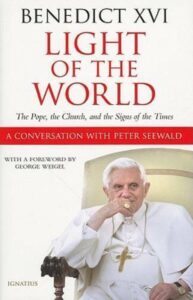
 In Light of the World: The Pope, the Church, and the Signs of the Times, an extended interview with Pope Benedict XVI by writer Peter Seewald, the former Pope discusses an idea expressed during the Babylonian Exile: “Our God is not one or another of many; he is the Creator, the God of heaven; the one God.” According to the Pope, “this core concept later became a meeting place between the Old Testament and Greek civilization. For at approximately the same time as the Babylonian exile singled out in particular this feature of the Old Testament, Greek philosophy also developed, which looked beyond the gods and inquired about the one God.” At ex libris—main bookshelf,
In Light of the World: The Pope, the Church, and the Signs of the Times, an extended interview with Pope Benedict XVI by writer Peter Seewald, the former Pope discusses an idea expressed during the Babylonian Exile: “Our God is not one or another of many; he is the Creator, the God of heaven; the one God.” According to the Pope, “this core concept later became a meeting place between the Old Testament and Greek civilization. For at approximately the same time as the Babylonian exile singled out in particular this feature of the Old Testament, Greek philosophy also developed, which looked beyond the gods and inquired about the one God.” At ex libris—main bookshelf,  you can learn more about Light of the World and other works by Pope Benedict XVI and additional authors who’ve written books related to Bible study.
you can learn more about Light of the World and other works by Pope Benedict XVI and additional authors who’ve written books related to Bible study.
how is this relevant?
It’s easy to get absorbed in the history of what’s happening at the time of the Exodus and start thinking anything that occurred that long ago can’t possibly relate to men and women living in the present day. Commentaries in the study book You Shall Have No Other Gods: The Book of Exodus are designed to make it easier to reflect on ways that God’s Word applies to Christians. Additional reflection questions can be found on the online study pages and videos posted with each lesson.
 ? Read “An Ancient Book That Remains Relevant Today” on page 7 in You Shall Have No Other Gods: The Book of Exodus. Consider ways in which religious practices established during the Exodus influence the way Catholics worship.
? Read “An Ancient Book That Remains Relevant Today” on page 7 in You Shall Have No Other Gods: The Book of Exodus. Consider ways in which religious practices established during the Exodus influence the way Catholics worship.
? What details in the book of Exodus probably already are familiar to most Catholics?
? Consider what might be the most important way that the book of Exodus foreshadows Christianity.
? In what ways does the situation in the book of Exodus faced by the Hebrews in Egypt resemble situations in the present-day secular world?
? What are some ways in which Catholics can demonstrate faith in God in such a world?
? Moving forward with this study of the book of Exodus, consider how the events described in the biblical text shape the way that Catholics think about the sacrament of the Eucharist.
another video—one that could change the way you approach the Bible (40:44)
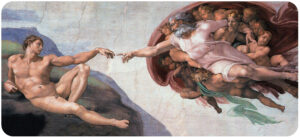 Even if you’re a veteran of Catholic Bible studies, we recommend that you watch an explanation of the practical benefits of approaching The Bible as the Living Word of God. This 40-minute video is distilled from a talk that Turning to God’s Word author Matthew Phelps gave at a summer Bible-study retreat at Conception Abbey in Conception, Missouri. In this video, Matthew looks at how viewing Scripture as a living document can help us to develop a more intimate relationship with Jesus Christ. There are real benefits in setting aside what we think we already know about Scripture to approach the Bible with the goal of learning what new things God is saying to us. Matthew examines the principles of lectio divina, the traditional Catholic approach to reading and praying with Scripture that’s foundational for all Turning to God’s Word Bible studies.
Even if you’re a veteran of Catholic Bible studies, we recommend that you watch an explanation of the practical benefits of approaching The Bible as the Living Word of God. This 40-minute video is distilled from a talk that Turning to God’s Word author Matthew Phelps gave at a summer Bible-study retreat at Conception Abbey in Conception, Missouri. In this video, Matthew looks at how viewing Scripture as a living document can help us to develop a more intimate relationship with Jesus Christ. There are real benefits in setting aside what we think we already know about Scripture to approach the Bible with the goal of learning what new things God is saying to us. Matthew examines the principles of lectio divina, the traditional Catholic approach to reading and praying with Scripture that’s foundational for all Turning to God’s Word Bible studies.
visual meditation is a form of prayer
If you like to draw, consider illustrating your prayers for You Shall Have No Other Gods: The Book of 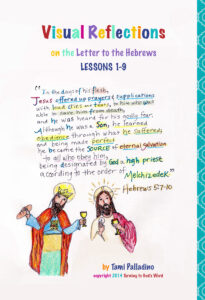 Exodus. Check out the visual-meditation journal that Turning to God’s Word co-
Exodus. Check out the visual-meditation journal that Turning to God’s Word co- founder Tami Palladino created to accompany another of our Catholic Bible studies: The Letter to the Hebrews: An Explanation of the Mechanism of Our Salvation. Tami also illustrated Sing a New Psalm: Communicating with God Through the Prayers of the Church—Volume I: Lauds & Vespers and The Revelation of Jesus Christ: The Faithful Witness, as well as some of the lessons this Bible study and In the Beginning: The Book of Genesis.
founder Tami Palladino created to accompany another of our Catholic Bible studies: The Letter to the Hebrews: An Explanation of the Mechanism of Our Salvation. Tami also illustrated Sing a New Psalm: Communicating with God Through the Prayers of the Church—Volume I: Lauds & Vespers and The Revelation of Jesus Christ: The Faithful Witness, as well as some of the lessons this Bible study and In the Beginning: The Book of Genesis.
Q&A—where to find some answers
Some people who are used to doing Bible studies from other publishers miss the answer keys included in those studies. One leader even admitted to us that she relied on answer keys so she didn’t have to spend time doing Bible study lessons herself. We sympathize with omnipresent time constraints, but we maintain that up-front answer keys provide people with a strong temptation to rely on someone else’s idea of what Scripture means instead of thinking more deeply about what God might be trying to say to them personally at that moment.
 Q: Why don’t Turning to God’s Word Catholic Bible studies provide any printed answer keys?
Q: Why don’t Turning to God’s Word Catholic Bible studies provide any printed answer keys?
A: The Turning to God’s Word method of Bible study depends on participants engaging with the biblical text for answers to their questions. All of the factual questions in the lessons can be answered from the Scriptures. Sidebars in the lessons contain material that may help explain some of the themes suggested by the biblical text. Most of our studies, including this one, feature videos with each lesson.
Outside commentaries can shed light on individual texts, but many commentaries examine Scripture passages out of context. Some may focus on an academic rather than a spiritual approach to the Bible. If you’re confused about anything in our studies or in any related outside commentaries, we encourage you to browse our website for more information.
The goal of all Turning to God’s Word Catholic Bible studies is to foster personal reflection leading to a more intimate relationship with Jesus. Consequently, each lesson contains  reflection questions, and these necessarily don’t have any “right” or “wrong” answers. If you’d like to share your thoughts about any of our studies or need clarification about a question, commentary, or video related to the lessons, contact us using the “ask us your question” or “what do you think” button on any online lesson page. Because others may have the same concern, we routinely turn questions and comments we receive into anonymous Q&A items and add them to the relevant online study pages
reflection questions, and these necessarily don’t have any “right” or “wrong” answers. If you’d like to share your thoughts about any of our studies or need clarification about a question, commentary, or video related to the lessons, contact us using the “ask us your question” or “what do you think” button on any online lesson page. Because others may have the same concern, we routinely turn questions and comments we receive into anonymous Q&A items and add them to the relevant online study pages
Q&A—three questions about Bible translations
We’re frequently asked what translation of the Bible is best. Sometimes we’re asked which translation is approved to be read at Catholic Masses. More infrequently we’re asked why we’ve chosen to reprint the Revised Standard Version Second Catholic Edition (RSV2CE) for the biblical text in our printed studies.
Q1: Which translation of the Bible is the best one for Catholics to read? 
A2: As far as which translation is “best,” we maintain that reading any translation of the Bible you have on hand is a great place to start. The old adage “every translator is a traitor” certainly applies to Scripture, but God’s basic message to his people can be found in any Bible. While there are English-language Bibles catering to a variety of special-interest Catholic groups, they generally reprint either a translation of the New American Bible Revised Edition (the NABRE) or a Catholic edition of the Revised Standard Version (the RSVCE or the RSV2CE), which are the Bibles read by most American Catholics. Both of these translations rely on archeological finds and scholarship that were unavailable in earlier centuries. Prior to the mid-1960s, many Catholics were familiar with the Douay-Rheims English translation, which was based on the Latin Vulgate. Originally translated by St. Jerome in the late 4th century, a version of the Vulgate has remained the official Latin translation of the Catholic Church since the 16th century. Prior to the mid-1960s, most Protestants read The King James Version.
As people become more interested in Scripture study, they also become more interested in reading the “right” Bible. Since very few of us are proficient in ancient languages, we’re forced to rely on the work of scholars who’ve spent years studying Hebrew, Greek, Aramaic, and Latin. In many cases, there simply isn’t an easy way to translate some of the original words and phrases of Scripture into English. The best advice we can offer is to choose an English translation that the Church has approved. The United States Conference of Catholic  Bishops (USCCB) offers guidelines. When questions arise, as they undoubtedly will, check out footnotes, commentaries, and other translations; talk to a knowledgeable priest; and—this part is most important—ask God to grant you increased understanding. You also can email us with your questions about Scripture. In many cases, Turning to God’s Word author Matthew Phelps’ background in classical languages proves helpful. We frequently rely on him to shed some light on the linguistics involved in difficult passages
Bishops (USCCB) offers guidelines. When questions arise, as they undoubtedly will, check out footnotes, commentaries, and other translations; talk to a knowledgeable priest; and—this part is most important—ask God to grant you increased understanding. You also can email us with your questions about Scripture. In many cases, Turning to God’s Word author Matthew Phelps’ background in classical languages proves helpful. We frequently rely on him to shed some light on the linguistics involved in difficult passages
Q2: I’m having trouble locating the same Bible that I hear read at Mass. What translation is that?
A2: The Catholic Lectionary, a collection of biblical texts approved for liturgical use, isn’t the same as a Bible. The English-language lectionary used in the United States is primarily based on a 1970 translation. A close English translation outside the lectionary is the New American Bible Revised Edition (NABRE). The United States Conference of Catholic Bishops (USCCB) currently is working on a liturgical Bible based on the NABRE translation.
Q3: Why has Turning to God’s Word chosen to reprint biblical text from the Revised Standard Version Second Catholic Edition (RSV2CE) instead of the New American Bible Revised Edition (NABRE)?
A3: We currently use the Revised Standard Version Second Catholic Edition (RSV2CE) as our primary biblical translation in our printed studies because scholars consider it to be a more faithful word-for-word translation than many other translations. Pope Benedict XVI quotes from the RSV2CE in his three-volume book, Jesus of Nazareth. The RSVCE is the Bible translation used in English translations of the Catechism of the Catholic Church. The RSV2CE varies only slightly from the earlier RSVCE, which we link to on our online study pages. Any discrepancies between the RSV2CE and the RSVCE are pointed out on the online study pages. Turning to God’s Word cites The Abbey Psalms and Canticles in references to the Psalms in all of our printed studies.
pray with the Psalms—intensely emotional prayers
Although some scholars question David’s authorship of the Psalms, it remains indisputable that many of the Psalms address  themes related to events that occurred during the period when David ruled over the descendants of Jacob. Reading and praying with the Psalms offers insight into the minds and hearts of people who lived during the time of David—and long afterward as well. These prayers express universal human feelings every bit as relevant to us in the present day as when the Psalms first were composed.
themes related to events that occurred during the period when David ruled over the descendants of Jacob. Reading and praying with the Psalms offers insight into the minds and hearts of people who lived during the time of David—and long afterward as well. These prayers express universal human feelings every bit as relevant to us in the present day as when the Psalms first were composed.
don’t get confused—Psalms numbering varies
Numbering of many of the Psalms and their verses varies from one translation to another. Parallel  numbering for commonly used Catholic Bibles is noted in the citations index in the back of the study book You Shall Have No Other Gods: The Book of Exodus and on the back pages of the sample lesson. You can learn more about why numbering of some Psalms varies in some translations, see the Q&A on the online study page for Lesson 1 Set a Guard on My Mouth in the Turning to God’s Word Catholic Bible study Sing a New Psalm: Communicating with God Through the Prayers of the Church—Volume I: Lauds & Vespers.
numbering for commonly used Catholic Bibles is noted in the citations index in the back of the study book You Shall Have No Other Gods: The Book of Exodus and on the back pages of the sample lesson. You can learn more about why numbering of some Psalms varies in some translations, see the Q&A on the online study page for Lesson 1 Set a Guard on My Mouth in the Turning to God’s Word Catholic Bible study Sing a New Psalm: Communicating with God Through the Prayers of the Church—Volume I: Lauds & Vespers.
 the best Catholic commentary about Scripture
the best Catholic commentary about Scripture
To find out more about how Church teaching is supported by Scripture passages in You Shall Have No Other Gods: The Book of Exodus, check out the Index of Citations in the Catechism of the Catholic Church. Links (Revised Standard Version Catholic Edition [RSVCE*]) to the primary Scripture passages in the lesson and relevant paragraphs in the Catechism are provided here. Not every passage in the biblical text for this Catholic Bible study is referenced in a Catechism paragraph, however, including the passage in this lesson from the book of Exodus 1:1–22.
ways our glossary might prove helpful
In addition to providing extra information about geographical locations, our glossary also points out  when a person or place is mentioned in the biblical text under more than one name or more than one spelling. If you can remember a name but aren’t sure in which lesson it shows up, you can find it in the glossary, which lists every proper noun that appears in the biblical text for every lesson in You Shall Have No Other Gods: The Book of Exodus.
when a person or place is mentioned in the biblical text under more than one name or more than one spelling. If you can remember a name but aren’t sure in which lesson it shows up, you can find it in the glossary, which lists every proper noun that appears in the biblical text for every lesson in You Shall Have No Other Gods: The Book of Exodus.
to learn more, read more Scripture
If you’re having difficulty with a particular passage of Scripture, it can be helpful to read the relevant  cross references—but looking these up can take time. To make that easier, we’ve compiled the cross references from the Revised Standard Version Second Catholic Edition (RSV2CE)—the translation that we reprint in our study books. That list can be found at the top of every online study page, and it includes links to cross references in the primary biblical text for You Shall Have No Other Gods: The Book of Exodus.
cross references—but looking these up can take time. To make that easier, we’ve compiled the cross references from the Revised Standard Version Second Catholic Edition (RSV2CE)—the translation that we reprint in our study books. That list can be found at the top of every online study page, and it includes links to cross references in the primary biblical text for You Shall Have No Other Gods: The Book of Exodus.
don’t forget about our indexes & extra online material

 If you’re trying to locate information about a specific Scripture passage, you can look it up in the index at the back of the study book or sample lesson. If you want to find a particular commentary, you can look up its title in the topics index. To learn more about another book of the Bible for which there’s a Turning to God’s Word study, visit the online study directories to read the commentaries and watch any accompanying videos. Finally, if you have a question or would like to make a comment about any of our studies, you can use one of the “ask us your question” or “what do you think” buttons to email our authors.
If you’re trying to locate information about a specific Scripture passage, you can look it up in the index at the back of the study book or sample lesson. If you want to find a particular commentary, you can look up its title in the topics index. To learn more about another book of the Bible for which there’s a Turning to God’s Word study, visit the online study directories to read the commentaries and watch any accompanying videos. Finally, if you have a question or would like to make a comment about any of our studies, you can use one of the “ask us your question” or “what do you think” buttons to email our authors.
ex libris—Church documents & books about religious topics
Link to magisterial documents referred to in our Bible studies at ex libris—magisterial documents.  This listing includes significant recent encyclicals as well as a number of historical Church documents. Recommended books related to Scripture study can be found at ex libris—main bookshelf.
This listing includes significant recent encyclicals as well as a number of historical Church documents. Recommended books related to Scripture study can be found at ex libris—main bookshelf.
memorize a favorite Bible verse (4:46)
Turning to God’s Word co-founder Tami Palladino has created a short video about the benefits of memorizing Bible verses. Choosing a passage that you find particularly meaningful will make the task easier. There are inspiring verses in every book of the Bible, but some people in our Turning to God’s Word Catholic Bible studies like to memorize a verse from their lesson every week. For more ideas, check out Tami’s video, Why Memorize Scripture? It’s less than five minutes long.
wondering how to pronounce some of these words?
The following link is to a reading from the New International Version (NIV) Bible. To listen, open the link and click on the audio icon above the printed text. Although not taken from the translations used in our study materials, the NIV reading provides an audio guide to pronunciation of words in this lesson’s primary biblical text. A close online version of the translation of the Bible used in Catholic liturgy in the United States as well as an audio guide for daily Mass readings for the current month can be found on the website of the United States Conference of Catholic Bishops (USCCB).
the book of Exodus 1:1–22 (NIV)
 close with Bible-based prayer related to this lesson
close with Bible-based prayer related to this lesson
Many of our Catholic study groups like to conclude their discussions with a prayer based on the scriptural focus of their lesson, and some participants include Scripture-specific prayer in their individual study. If you’re uncomfortable composing your own Bible-based prayers, you can follow our four easy steps, or you can use the following prayer based on this lesson’s texts from the book of Exodus.
O God, throughout the ages you have remained faithful to your people
under all types of circumstances.
Give us the strength to remain faithful to you
and to accept your will even in difficult situations.
We ask this in the name of Jesus Christ,
who leads his imperfect Church along the path of righteousness
toward the perfection of heaven—
the ultimate Promised Land. Amen.
Lesson 2 God Hears His People Groaning—the book of Exodus 2:1–25
you also may like our study of the book of Genesis
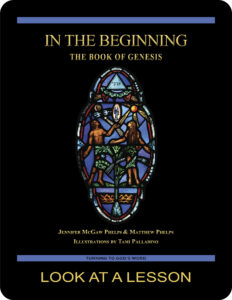 The first seven lessons of In the Beginning: The Book of Genesis, a 28-lesson Catholic Bible study with an imprimatur, provide an in-depth look at the very earliest biblical history—including the two accounts of Creation, events surrounding the Fall of Adam and Eve, the relationship between Cain and Abel, and the baptismal foreshadowing present in the account of Noah and the Flood. Remaining lessons look at lives of the patriarchs Abraham, Isaac, Jacob, and Joseph. Click on the book’s cover to view a sample lesson.
The first seven lessons of In the Beginning: The Book of Genesis, a 28-lesson Catholic Bible study with an imprimatur, provide an in-depth look at the very earliest biblical history—including the two accounts of Creation, events surrounding the Fall of Adam and Eve, the relationship between Cain and Abel, and the baptismal foreshadowing present in the account of Noah and the Flood. Remaining lessons look at lives of the patriarchs Abraham, Isaac, Jacob, and Joseph. Click on the book’s cover to view a sample lesson.
start a Turning to God’s Word Bible study
 Thank you for your interest in You Shall Have No Other Gods: The Book of Exodus.
Thank you for your interest in You Shall Have No Other Gods: The Book of Exodus.  Information about beginning a Turning to God’s Word Bible study can be found at start a Bible study. Tami, Matthew, and I are available to answer questions and offer support. Contact us if you’d like to start one of our studies or have your schedule listed with other TtGW study groups on our website. —Jennifer
Information about beginning a Turning to God’s Word Bible study can be found at start a Bible study. Tami, Matthew, and I are available to answer questions and offer support. Contact us if you’d like to start one of our studies or have your schedule listed with other TtGW study groups on our website. —Jennifer
*There are seven deuterocanonical books in the Old Testament—the Books of Tobit, Judith, Wisdom, Sirach, Baruch, and First and Second Maccabees, as well as some passages in the Books of Esther and Daniel. Protestants usually refer to these works as “apocryphal,” a word that means “outside the (Protestant) canon” because they’re excluded from most Protestant Bibles. The word “deuterocanonical” means “second canon”; Catholics use that word to refer to any section of the Catholic Old Testament for which there are no extant, or existing, Hebrew manuscripts. All of the deuterocanonical books appear in the Septuagint, the earliest remaining versions of which date to the 1st century B.C. This Greek translation of the Old Testament was in common use by Jews at the time of Jesus—but the same books aren’t found in existing Hebrew manuscripts, which aren’t as old as the oldest version of the Septuagint. Learn more by reading How Do Catholic & Protestant Bibles Differ?
Turning to God’s Word printed Bible studies use the 2006 Revised Standard Version Second Catholic Edition (RSV2CE) translation for all Scripture references except those to the Psalms, which are taken from The Abbey Psalms and Canticles, prepared by the Benedictine monks of Conception Abbey and published in 2020 by the United States Conference of Catholic Bishops (USCCB). All Scripture links for the online study pages for You Shall Have No Other Gods: The Book of Exodus are to the 1966 Revised Standard Version Catholic Edition (RSVCE) translation. The New International Version (NIV) audio recordings follow the same chapter and verse numbering as the RSV Catholic translations, but the NIV translation doesn’t include the deuterocanonical books and passages.
The 1966 RSVCE uses archaic pronouns and verb forms such as “thee,” “thou,” “didst” in the Psalms and in direct quotations attributed to God. The 2006 RSV2CE replaces those with more accessible English. The few significant translation changes in the RSV2CE include rendering almah as “virgin” in the Book of Isaiah 7:14 and restoring the term “begotten” in the Gospel According to John 3:16.
Numbering varies for some passages in this Bible study. Turning to God’s Word studies (print and digital) follow the numbering in the Revised Standard Version Catholic translations (RSV2CE and RSVCE). Discrepancies in the New American Bible Revised Edition (NABRE) are noted in the Index of Scripture Citations in the study book and the online sample.
 You can learn more about the Psalms by viewing a sample lesson from the Turning to God’s Word Catholic Bible study Sing a New Psalm: Communicating with God Through the Prayers of the Church—Volume I: Lauds & Vespers. The second part of that study, Sing a New Psalm: Communicating with God Through the Prayers of the Church—Volume II: Vigils, Day Prayer & Compline, is scheduled for publication in 2025. Some verse numbers may vary in different translations of the Psalms.
You can learn more about the Psalms by viewing a sample lesson from the Turning to God’s Word Catholic Bible study Sing a New Psalm: Communicating with God Through the Prayers of the Church—Volume I: Lauds & Vespers. The second part of that study, Sing a New Psalm: Communicating with God Through the Prayers of the Church—Volume II: Vigils, Day Prayer & Compline, is scheduled for publication in 2025. Some verse numbers may vary in different translations of the Psalms.
